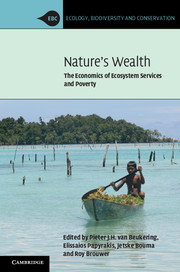Book contents
- Frontmatter
- Contents
- List of contributors
- Acknowledgements
- 1 The economics of ecosystem services and poverty
- Part I Biodiversity-related ecosystem services
- Part II Marine-related ecosystem services
- Part III Forest-related ecosystem services
- 8 Greening the charcoal chain in Tanzania
- 9 Payments for environmental services in the protected areas of the Philippines
- 10 The copper curse and forest degradation in Zambia
- 11 Institutions and forest management in the Swat region of Pakistan
- Part IV Water-related ecosystem services
- Part V Land-related ecosystem services
- Index
- References
10 - The copper curse and forest degradation in Zambia
Published online by Cambridge University Press: 05 July 2013
- Frontmatter
- Contents
- List of contributors
- Acknowledgements
- 1 The economics of ecosystem services and poverty
- Part I Biodiversity-related ecosystem services
- Part II Marine-related ecosystem services
- Part III Forest-related ecosystem services
- 8 Greening the charcoal chain in Tanzania
- 9 Payments for environmental services in the protected areas of the Philippines
- 10 The copper curse and forest degradation in Zambia
- 11 Institutions and forest management in the Swat region of Pakistan
- Part IV Water-related ecosystem services
- Part V Land-related ecosystem services
- Index
- References
Summary
Introduction
Amongst the most striking empirical relationships uncovered over the last ten to fifteen years has been the negative causal link between several measures of resource dependence and economic development. Resource-based economic development has not proven to be a great success amongst developing nations; as a matter of fact, poor nations deprived of minerals, fertile land and forests performed better compared to their resource-rich counterparts. Recent empirical evidence and theoretical work provide strong support to a resource curse hypothesis; i.e. natural wealth tends to retard rather than promote economic growth (Auty 1994, Gylfason 2000, 2001a,b, Leite and Weidmann 1999, Papyrakis and Gerlagh 2004, Rodriguez and Sachs 1999, Sachs and Warner 1995 1997, 1999a,b, 2001). The most prominent example is certainly the Organization of the Petroleum Exporting Countries (OPEC) with a disappointing annual growth rate of –1.3% on average between 1965 and 1998 despite the significant injections of petrodollars into their local economies from the oil extractive industries (Gylfason 2001a). The expectations of many early development economists (Nurkse 1953, Rostow 1960, Watkins 1963) that resource endowments could potentially support economic expansion by attracting funds from foreign creditors, channelling the primary sector rents into productive investment and escaping ‘poverty traps’ proved to be unrealistic. Similarly, any positive linkages between resource abundance and economic prosperity observed during the origins of the industrial revolution in Great Britain, Germany and the United States or more recently in countries such as Botswana, Norway and Iceland appear to be exceptional cases rather than belonging to a general applicable rule (Sachs and Warner 1995, Wright 1990).
- Type
- Chapter
- Information
- Nature's WealthThe Economics of Ecosystem Services and Poverty, pp. 217 - 233Publisher: Cambridge University PressPrint publication year: 2013



